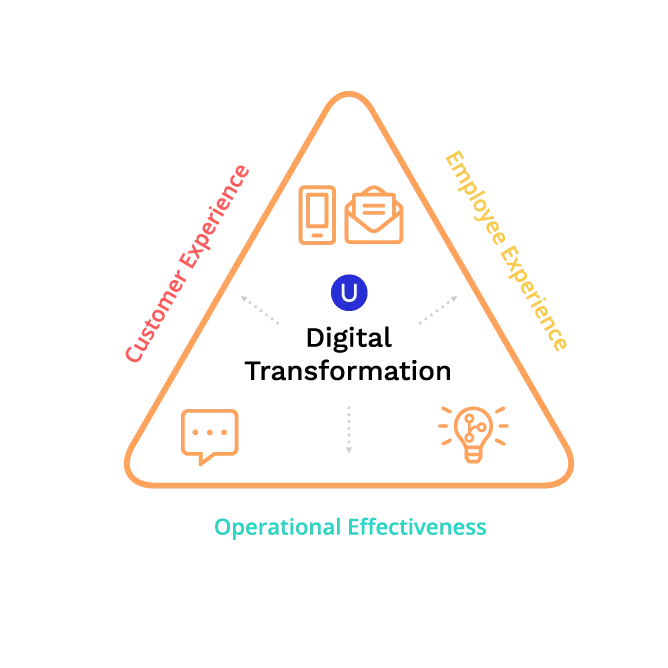Transforming the Customer Experience


When embarking on a digital transformation journey, insurance companies need to think, act, and expect differently than they have in the past. Otherwise, they will find themselves literally in an insanity loop, doing the same thing over and over and yet expecting a different outcome. Gone are the days where a project management triangle mindset requires choosing where to create value – customer experience or operational effectiveness or employee engagement. Agility coupled with the right solution enables a carrier to improve all three critical dimensions at the same time. How is that possible? Read on – this is the first edition of our three-part blog series – focused on customer experience.

In this installment we will talk about the customer experience leg of our digital transformation triangle. I’m a firm believer in taking a customer-first approach. If we address the customer needs first, operational effectiveness and employee experience will naturally be improved.
So, what does it actually mean to take a customer-first approach? It means to meet the customer where they are. To interact with them when they prefer and through the channel they prefer. You want your customers to walk away from every engagement feeling pleasantly surprised at how easy it is to do business with your organization.
We used to think of digital engagement as a millennial imperative, but a recent Gartner study showed that 85% of customers expect to manage their business relationships without interacting with a human. A report by Microsoft further tells us that 66% of customers will try to self-serve before engaging with a human – regardless of age.
And make no mistake, these preferences matter. I’m a Gen Xer and 9 times out of 10, I would prefer not to talk to a human. I’m too busy. I want quick, digital resolution of service issues. If I do interact with a person, I want it to be in a chat. I recently added my 16-year-old son to my auto policy. I tried to handle it via my insurer’s self-service portal. I entered the information and sent it off to be processed. It got so messed up through these “easy digital” channels that I literally ended up spending hours, yes HOURS, over a period of a week on the phone with my agent. I repeatedly asked him to email me, and he kept calling me. The experience was so painful that I almost changed carriers – after being a customer for over 20 years.
When we stick these digital front ends on top of our same old processes and problems, it is often akin to putting lipstick on a pig. It’s fantastic that I could submit a policy change online. But if it then goes into a black hole, or in this case gets messed up because we’re not collecting the right information, my customer experience was not really improved. In fact, it’s gotten worse – much worse.
So how do insurance companies avoid this trap? To truly transform a customer’s digital experience, you must first understand who your customers are. Most insurers will have several types of customers (including key stakeholders) – policyholders and sometimes their employees, brokers, agents, and providers to name a few – and they all have different needs. Then you must fully map out each customer’s journey. What are all the interaction points? Which ones have the most friction? What can you solve now? What can you do to improve areas you can’t solve now? And for each interaction, what does your customer need – what is their end goal? For example, in my recent experience it was not to submit a policy change – it was for the policy to be immediately and accurately endorsed and billed, to know that when my new driver inevitably dings someone’s fender – he is covered.
Once you’ve examined the entire customer journey and how you will transform it – you can start incrementally and iteratively improving as you reach toward the new ideal. Let’s look at the claims process to see how this could be put into practice. When my son inevitably dings someone’s fender, what would I want my experience to look like? There are some companies who allow claims to be submitted online. This may include being able to take photos of minor damage and for an adjuster to evaluate and resolve the claim virtually. Carriers may offer a customer portal, giving the option to login to see the status of a claim.
Ok that’s a great start, but it’s not transformational. What if instead of making the customer come to their carrier to request information, the company proactively sent them updates? Think about ordering a pizza (something I’ve done way too many times during the pandemic). It tells me that my order was received, when it’s cooking, when my driver picks it up, and when it’s on its way to me with an estimated arrival time. What if when I submitted a claim, I was shown all the steps it would need to go through, how long each step may take and where I was in the process? And even better – what if this tracker was sent to me each time the status of my claim changed? Arming me with that information up front proactively manages my expectations, and sending frequent, meaningful updates keeps me from having to chase down the status myself. Frankly, I think everything should have a pizza tracker.
Taking it one step further, if additional information was needed by my carrier to process my claim, what if I received a text interaction to provide that information? What if I was able to receive and sign any necessary documents electronically on my phone? What if I was even given a secure link to enter my banking information so my claim check could be automatically deposited?
That is a transformational customer experience. That is an experience that will keep me as a customer for another 20 years. And guess what? In the process we have improved operational effectiveness by reducing inbound calls and emails from customers wanting to know the status of their claim. And made claims employees happier by freeing them up from endless games of phone tag. But I won’t go too far into that as I don’t want to spoil Meredith Barnes-Cook’s next installment on operational effectiveness.